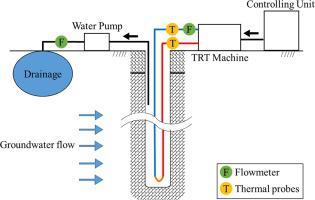当前位置:
X-MOL 学术
›
Energy Convers. Manag.
›
论文详情
Our official English website, www.x-mol.net, welcomes your
feedback! (Note: you will need to create a separate account there.)
Evaluation of ground source heat pump system’s enhancement by extracting groundwater and making artificial groundwater velocity
Energy Conversion and Management ( IF 9.9 ) Pub Date : 2020-11-01 , DOI: 10.1016/j.enconman.2020.113298 Saeid Mohammadzadeh Bina , Hikari Fujii , Hiroyuki Kosukegawa , Hadi Farabi-Asl
Energy Conversion and Management ( IF 9.9 ) Pub Date : 2020-11-01 , DOI: 10.1016/j.enconman.2020.113298 Saeid Mohammadzadeh Bina , Hikari Fujii , Hiroyuki Kosukegawa , Hadi Farabi-Asl

|
Abstract This study used moving line source technique as a practical approach to simultaneously determine effective thermal conductivity, groundwater velocity and borehole resistance. It mainly focused on the applicability of this approach for observing the effect of groundwater extraction, in particular for ungrouted ground heat exchangers. The thermal response tests were carried out for different ground heat exchangers at two sites on the Akita University campus, northern Japan. The test conditions varied, based on different borehole filling condition (grouted/ungrouted), heat loads and presence of an extra pump for groundwater extraction. The hydro-thermal parameters of the ground were determined by a MATLAB code, especially for consideration of the effect of artificial groundwater velocity under a special test, where a water pump extracts the groundwater from the casing of the borehole during the test. This method can estimate the groundwater velocity and the effective thermal conductivity of the soil by reproducing the temperature distribution in the well and minimizing the root mean squared error between the calculated results and the measured data. As a result, the groundwater velocity and thermal conductivity calculated by this method improved to 205.3 cm/day and 7.48 W/m K, respectively, due to presence of the external pump, whereas the undisturbed groundwater velocity in the other cases without pumping was estimated in the range of 15 to 16 cm/day. Furthermore, the minimum groundwater velocity and thermal conductivity were reported for the grouted well as being equal to 10.79 cm/day and 1.16 W/m K, respectively.
中文翻译:

地源热泵系统提取地下水和人工地下水流速增强评价
摘要 本研究使用移动线源技术作为一种实用的方法来同时确定有效热导率、地下水流速和钻孔阻力。它主要侧重于这种方法在观察地下水提取效果方面的适用性,特别是对于未灌浆的地下换热器。在日本北部秋田大学校园的两个地点对不同的地面换热器进行了热响应测试。测试条件根据不同的钻孔填充条件(灌浆/未灌浆)、热负荷和是否存在用于抽取地下水的额外泵而有所不同。地层的水热参数由MATLAB程序确定,特别是在特殊试验下考虑人工地下水流速的影响,在测试过程中,水泵从钻孔套管中抽取地下水。该方法可以通过再现井内温度分布并最小化计算结果与实测数据之间的均方根误差来估计地下水流速和土壤的有效导热系数。结果,由于外部泵的存在,通过这种方法计算的地下水速度和热导率分别提高到 205.3 cm/day 和 7.48 W/m K,而在其他没有泵的情况下,未受干扰的地下水速度被估计在 15 至 16 厘米/天的范围内。此外,据报道,灌浆井的最小地下水流速和热导率分别等于 10.79 cm/day 和 1.16 W/m K。
更新日期:2020-11-01
中文翻译:

地源热泵系统提取地下水和人工地下水流速增强评价
摘要 本研究使用移动线源技术作为一种实用的方法来同时确定有效热导率、地下水流速和钻孔阻力。它主要侧重于这种方法在观察地下水提取效果方面的适用性,特别是对于未灌浆的地下换热器。在日本北部秋田大学校园的两个地点对不同的地面换热器进行了热响应测试。测试条件根据不同的钻孔填充条件(灌浆/未灌浆)、热负荷和是否存在用于抽取地下水的额外泵而有所不同。地层的水热参数由MATLAB程序确定,特别是在特殊试验下考虑人工地下水流速的影响,在测试过程中,水泵从钻孔套管中抽取地下水。该方法可以通过再现井内温度分布并最小化计算结果与实测数据之间的均方根误差来估计地下水流速和土壤的有效导热系数。结果,由于外部泵的存在,通过这种方法计算的地下水速度和热导率分别提高到 205.3 cm/day 和 7.48 W/m K,而在其他没有泵的情况下,未受干扰的地下水速度被估计在 15 至 16 厘米/天的范围内。此外,据报道,灌浆井的最小地下水流速和热导率分别等于 10.79 cm/day 和 1.16 W/m K。











































 京公网安备 11010802027423号
京公网安备 11010802027423号